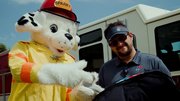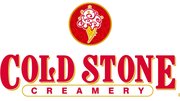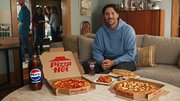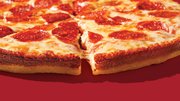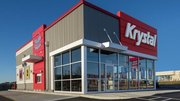News
In-N-Out Burger carves niche in the fast-food market
By traditional fast-food industry standards, In-N-Out Burger seemingly is as retail-savvy as a hash house chef grilling patties into hockey pucks. The Irvine-based chain's posted menu is the narrowest in the quick-serve sector: hamburger, cheeseburger, the Double Double (essentially a double cheeseburger), fries, three flavors of shakes and a variety of sodas.
July 26, 2003
July 27, 2003By traditional fast-food industry standards, In-N-Out Burger seemingly is as retail-savvy as a hash house chef grilling patties into hockey pucks. The Irvine-based chain's posted menu is the narrowest in the quick-serve sector: hamburger, cheeseburger, the Double Double (essentially a double cheeseburger), fries, three flavors of shakes and a variety of sodas. At lunchtime on weekdays, the wait at the drive-through at some outlets can extend to six minutes or more – an eternity in the fast-food business. And in a potentially unappetizing blend of commerce and religion, at least for some customers, In-N-Out wrappers and cups come imprinted with such biblical references as "Revelation 3:20," "John 3:16," "Proverbs 3:15" and "Nahum 1:7." But as one In-N-Out adherent said the other afternoon, while feasting on a Double Double on the patio of the company's Mission Valley store: "It's the food, stupid." In-N-Out Burger has gained unlikely cult-food status in California, where 167 of the intensely private family-run firm's 176 stores are located, including a dozen in San Diego County. Some of the company's loyal customers reportedly drive 50 miles or more, passing dozens of McDonald's and Carl's Jr. shops on the way, to sate their urge for a crunchy Double Double. This, even as In-N-Out goes to market every day with a product and retail strategy virtually unchanged since the company's founding in 1948. "We're the same as we've always been," said Carl Van Fleet, In-N-Out's vice president of planning. "It's something that has worked for us for a very long time." In-N-Out's growing success comes as its rivals in the fast-food industry are struggling in the sputtering economy to keep intact their core audience – males between 15 and 35. Those customers are increasingly seeking out alternative dining options, especially in the so-called quick-casual dining category personified by La Salsa, Pick Up Stix, Baja Fresh and other relatively upscale chains. McDonald's and Burger King, for instance, went through a bruising price war within the last year in an attempt to maintain and bolster market share. Menu makeovers at the major chains have also been evident to customers in recent months. San Diego-based Jack in the Box, for one, diversified its offerings this year to appeal to health-conscious consumers by adding premium "Ultimate Salads," including Asian chicken, Southwest chicken and chicken club. And for the second time in two years, Burger King last month introduced a burger it is touting as tasting like it came off the backyard grill. The so-called Great American Burger is the first step in Chief Executive Brad Blum's efforts to rejuvenate the chain's declining sales. But through it all, In-N-Out seemingly has been immune to the monumental changes rocking the industry. Sales at the chain's stores average $1.6 million a year – nearly double the typical take at a fast-food outlet – according to the trade magazine QSR, which estimated In-N-Out's total 2001 revenue at $260 million. In-N-Out continues to rack up trade industry awards for superior food, beating out much larger rivals. This year, In-N-Out won the fast-food industry's prestigious Awards of Excellence for best taste and flavor of food and best quality of ingredients. The awards were based on a poll of 71,600 fast-food users across 61 markets in the United States. "In-N-Out's success shows that you don't have to be fancy, you don't have to be all things to all people, but be consistent," said Bob Sandleman, a restaurant consultant at Sandleman and Associates. Sandleman said his company's surveys of fast-food dining habits indicate that In-N-Out's customers are more than willing to wait a minute or two longer for the goods than they would at, say, McDonald's. "Believe it or not, they rate high on speed of service," said Sandleman, noting that people in the drive-through lane understand that the company makes its burgers and fries fresh-to-order. "That's all built into (customers') thinking, so they don't mark them down for service." Moreover, customers give In-N-Out the industry's highest marks for friendliness and courtesy – probably, Sandleman speculated, a reflection of the longtime commitment by the company's founders, the Snyder family, to pay employees above-average wages compared with the rest of the industry. Sandleman stressed that In-N-Out isn't perfect. The chain does not rate well, he said, in such categories as convenience, appeal to children and menu variety. However, several restaurant industry observers pointed out that the company has long fostered a "secret menu" for hard-core customers who occasionally weary of downing the same old Double Double. Order an "animal style," for instance, and the kitchen will serve up a burger cooked with mustard and garnished with pickles, extra spread and grilled onions. Among more than a dozen other variations: "Protein style" (The sandwich is wrapped in lettuce instead of a bun), "Flying Dutchman" (two beef patties and two slices of cheese, no bun) and the "2 by 4" (two beef patties and four slices of cheese). The first In-N-Out was opened by Harry and Esther Snyder in 1948 in Baldwin Park. A company history credits the firm with opening the first drive-through hamburger stand, complete with two-way speaker box. But the company was slow to expand, not opening its second outlet until 1951. To some, In-N-Out's stores looked similar to McDonald's, which likewise was a fledgling company in Southern California at the time. "They had the same red-and-white tile," noted Richard Adams, president of the San Diego-based Franchise Equity Group, which represents 600 McDonald's franchisees. One of the keys to the success of both firms was the simplicity of the menus, Adams said. "When I went to work for McDonald's in 1964, they served a 15-cent hamburger, a cheeseburger, one size of french fries, milkshakes in three flavors and Coke, root beer and orange soda," he recalled. "One of the problems at McDonald's during the last 10 years is that its menu has become complicated." When Harry Snyder died in 1976, there were only 18 In-N-Out locations, most of them in the Los Angeles region. Rich Snyder, one of Harry and Esther's two sons, subsequently took over as president of the business with the help of his brother, Guy. They established a central commissary, which allowed the company to have quality control over all menu ingredients at its stores, as well as a "university" where store managers were trained. In the mid-1980s, Rich Snyder, who was deeply religious, instituted the practice of printing biblical references on company packaging. "It was something he wanted to do, something important to him," Van Fleet said. Rich Snyder died in a plane crash in 1993, and his brother succeeded him as the company's top executive. During the next six years, until Guy's death in 1999, the company expanded into Arizona and Nevada, and grew from 93 outlets to 140. Van Fleet said the family matriarch, Esther Snyder, the company's president, still works in the corporate office every day. In-N-Out has been growing by about 10 new sites a year, and Van Fleet said the company is interested in expanding its presence in San Diego County. But don't call the firm asking about the availability of franchises; all In-N-Out stores are corporate-owned. "With franchises, you begin to relinquish control," Van Fleet said, conceding the company could make substantial revenue opening the door to franchisees. Van Fleet acknowledged that In-N-Out's marketing approach might seem to go against the grain of hard-nosed retail strategy. For one thing, the company pays starting employees $8.25 an hour – substantially higher than other major fast-food chains. Store managers can see their compensation over the years jump to more than $85,000 a year, the company's Web site says. The strategy apparently instills worker loyalty, because the average manager at the company has been employed there for 13 years or so. Relatively high wages are "in keeping with the Snyder family's values and principles," Van Fleet added. Van Fleet said In-N-Out has resisted getting drawn into industry marketing skirmishes, such as the recent fast-food price wars that saw Whopper and Big 'n' Tasty sandwiches on sale for a money-losing 99 cents. There's no reason to participate, company officials say. "We have not seen a shortage of lines" when other chains were drastically discounting food in attempts to steal market share, Van Fleet said.Variations on a theme"Animal Style":Bun is grilled with mustard, sauteed onions, pickles, extra "special sauce""Wish Burger":No meat, i.e. veggie burger"Protein Style":Lettuce wrapped around the burger instead of a bun for all of you who are in "The Zone""Old Fashioned Style":Ketchup and mustard instead of the weird special sauce"Flying Dutchman":Two meat patties with two slices of cheese. that's it."Double Meat":Double Double, no cheese"4x4":4 meat patties, 4 slices of cheese."2x4":2 meat patties with 4 slices of cheese."Grilled Cheese":Cheeseburger, sans meat"Fries - well done":Get your fries extra crispy and brown the way you like them!"Choco-Vanilla Swirl Shake":Just what it sounds like"Neopolitan Shake":Blend of chocolate, vanilla and strawberry shakes.source:www.zenlemur.com
